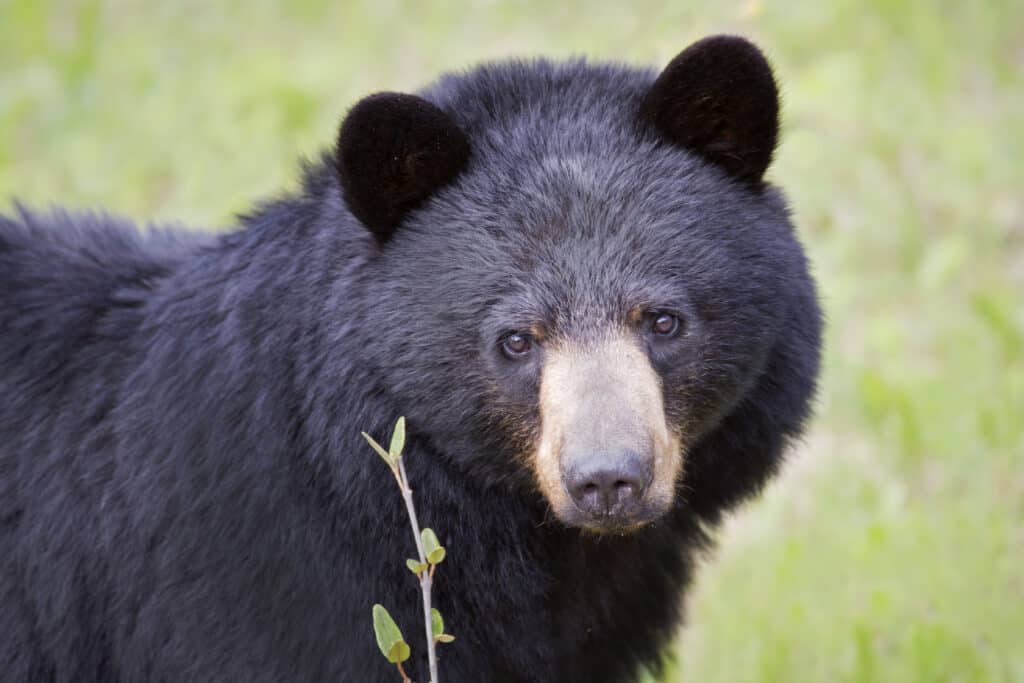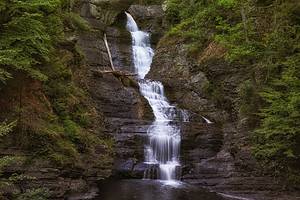Massachusetts is an excellent state for nature lovers, with its beautiful state parks, hiking trails, historic sites, and, last but not least, its waterfalls. The falls in this state are famous for the thick forests and magnificent views surrounding them. However, the tallest waterfall in Massachusetts is truly a sight to behold and far outshines the rest. But, sadly, its breathtaking beauty is overshadowed by its tragic past.
Tallest Waterfall in Massachusetts
The tallest water in Massachusetts is Bash Bish Falls, which sits in the southwest corner of the Bay State, on the New York border in the Berkshires. These magnificent falls have an 80-foot drop into an emerald pool. It’s a fantastic place for hikers and outdoor enthusiasts looking for a weekend away. Hiking from the New York entrance is much easier than starting in Massachusetts, perfect for novices and children. However, hiking from the Massachusetts entrance is much more challenging.
Firstly, you must drive to Bash Bish Falls State Park, look for the sign reading “scenic view,” and follow the trail. A roundtrip hike to the falls is approximately one mile, but the path is difficult and steep in certain areas. But climbing the steep trail will lead to spectacular views over Bash Bish Gorge. Just before reaching the falls, there is a sharp 300-foot descent, almost like a rocky staircase, so hikers must take extreme caution when descending and upon returning. While experienced hikers shouldn’t have an issue with this trail, it’s not recommended for novices, children, or people with mobility issues.

Bash Bish Falls is 80 feet tall!
©quiggyt4/Shutterstock.com
History of Bash Bish Falls
Legend has it that a beautiful Mohican woman named Bash Bish lived in a nearby village, was accused of adultery. Her accuser was rumored to be her best friend, who couldn’t contain her jealousy. The elders believed her friend and sentenced her to death by strapping her to a canoe and sending her over the falls. Her body was never found.
The village helped to raise Bash Bish’s daughter, White Swam, who married the chief’s son. Unfortunately, she couldn’t bear children, and the elders convinced the chief’s son to remarry. White Swan was so devastated that she flung herself off the falls to death. Many believe Bash Bish Falls is haunted by mother and daughter, and some claim they have seen their reflections in the emerald pool.
Who knows if the tallest falls in Massachusetts are truly haunted? After all, Bash Bish’s story is only a legend. However, it would be a good explanation for the tragic accidents at these falls. Sadly, 25 people drowned at Bash Bish Falls, most recently in 2017. However, a more plausible explanation is slippery rocks and human error. The State Park makes it abundantly clear that swimming and climbing the rocks is against the rules.

The best time to visit Bash Bish Falls is in the spring.
©Jennifer Yakey-Ault/Shutterstock.com
Best Time to Visit the Tallest Waterfall in Massachusettes
The best time to visit Bash Bish Falls depends on the individual. Every season has something to offer. Families like to hike in the Berkshires during the peak summer months. Therefore, you will likely run into kids of all ages on the trail from New York. However, fall provides a scenic backdrop of changing foliage. Visitors can enjoy views of forests covered in orange, red, and yellow leaves.
Most visitors tend to avoid visiting the falls in spring, but this is a mistake. Bash Bish Falls is most flush during spring, and visitors can enjoy the sights and smells of newly flowering plant life. Surprisingly, many people visit the falls in winter. But, ensure to have the proper equipment. For example, hikers must wear spiked boots to maneuver on the ice.
Wildlife in Bash Bish State Park
The falls aren’t the only spectacular thing in Bash Bish State Park. It also boasts several gorges and an eastern hemlock ravine forest. Additionally, the landscape surrounding the falls is covered with oak, maple, and beech forests, providing a home for abundant wildlife, like black bears, bobcats, timber rattlesnakes, porcupines, and the peregrine falcon.
Black Bears
In Massachusetts, black bears inhabit and breed in northern Middlesex County, Worcester County, and the Berkshires. However, some breeding females, but mostly young males, occur in eastern Massachusetts along Route 495. These bears have excellent eyesight, hearing, and smell, which they use to find food and detect potential danger. Furthermore, they are fantastic climbers and use these skills to evade threats and protect their offspring. Black bears’ mating season occurs between June and July. And they generally hibernate from November to March, depending on food availability and snow cover.

Black bears are generally only dangerous when provoked or hungry.
©Wild Art/Shutterstock.com
Bobcats
The only wild cat that inhabits Massachusetts is the bobcat. They are common in the western and central parts of the state. However, some also occur in the northeast and recently migrated to the southeast. Bobcats are carnivores and primarily prey on medium-sized animals like:
Occasionally these cats also prey on larger species like deer, but this is rare and only usually occurs when other food sources are scarce. They hunt by stalking their prey until they get close enough to pounce. Additionally, bobcats will hide in a tree or along a trail and ambush their prey or chase it down over a short distance. While these cats have a relatively good sense of smell, they mainly rely on their sharp eyesight and hearing to hunt and avoid threats.
Timber Rattlesnakes
The timber rattlesnakes used to inhabit ten of the 14 counties of Massachusetts. But unfortunately, they have seen a steady decline in population size over the past 150 years. As a result, they only occur in five localized mountainous areas within the Commonwealth. One of these areas is the tallest waterfall in Massachusetts, Bash Bish Falls. These snakes primarily inhabit deciduous ad mixed pine-oak areas in mountainous regions. In Massachusetts, timber rattlesnake populations overwinter in dens mostly situated on cliffs with loose rock piles, ledges, and bedrock crevices.
Other essential features include birthing areas, basking areas, and transitions from forest edges to fields. These rattlesnakes wait patiently for their prey and mainly feed on birds, rodents, other snakes, and amphibians. They are most active during the summer months and will return to their dens during autumn, where they will stay inactive for around six months.

Porcupines are herbivores that feed on plants and fruits, such as berries, leaves, and roots.
©Warren Metcalf/Shutterstock.com
Porcupine
The porcupine occurs around the tallest waterfall in Massachusetts but is also abundant across the state. They are notorious for their intimidating coat of quills, but spotting one is a rare occurrence since they are nocturnal. Therefore, their habits and activities are a bit of a mystery. These critters mainly occur in the central and western parts of Massachusetts, but residents occasionally see them in Middlesex County. Due to the lack of extensive forests, porcupines are rare in the state’s eastern and southeastern regions.
Porcupines only eat vegetation, making them herbivores. However, their diet varies depending on location and season. For example, during the warmer months, they feed on:
- Fruit
- Grass
- Berries
- Inner bark
- Twigs
- Buds
- Roots
- Leaves
- Tubers
But their absolute favorite food is apple, oak, maple, aspen, and ash trees. During the fall, their diet changes to beechnuts, hickory nuts, and acorns. If none fall to the floor, they will climb the tree and snip off the branch. Therefore, larger porcupines often fall from the trees, which can be fatal. In fact, researchers proved that 30% of porcupine skeletons sustained fractures from falling, resulting in their death.
Winter brings the toughest challenge, and porcupines need to adapt. When most of their food sources start to succumb to the cold, their diet changes to tree bark and conifer needles, but they prefer white pine, hemlock, and hardwood trees with smooth, thin bark.
Where is Bash Bish Falls Located on a Map?
Bash Bish Falls which is located in Bash Bish Falls State Park within the Taconic Mountains of southwestern Massachusetts, holds the title of being the highest waterfall in the state. This stunning waterfall consists of a series of cascades, totaling almost 200 feet in height.
Here is Bash Bish Falls on a map:
Thank you for reading! Have some feedback for us? Contact the AZ Animals editorial team.







